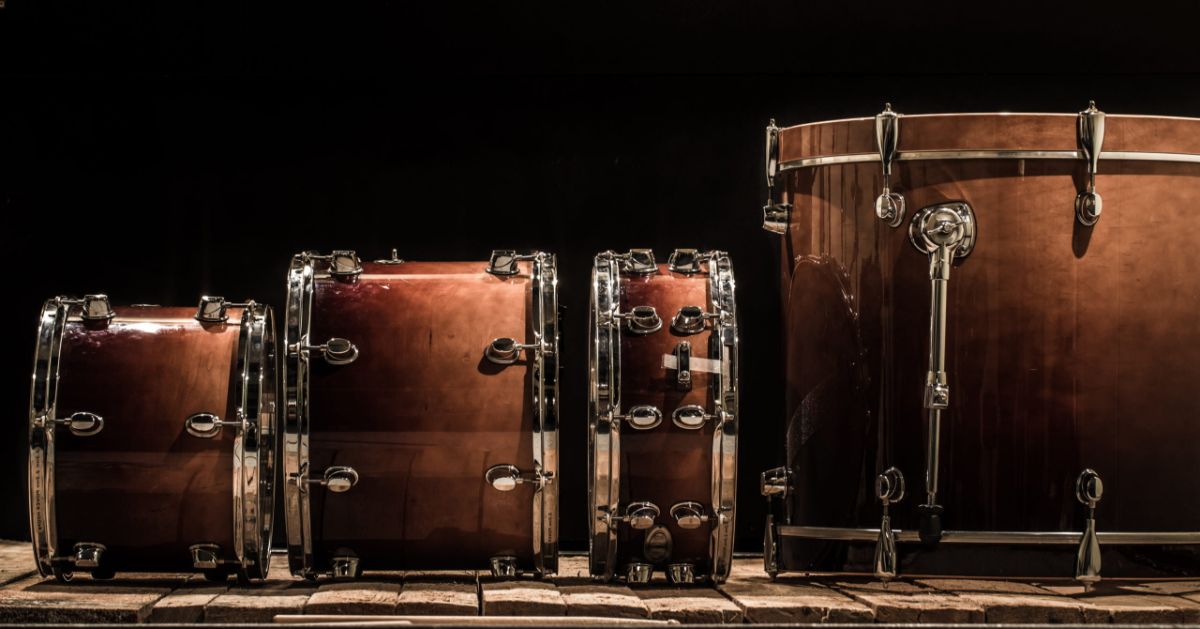Drums are widely believed to be the world’s oldest musical instrument – having been played by our prehistoric ancestors many thousands of years ago! As you may expect, drums come in many different forms.
The modern drum set however is a new invention. In this guide I’m going to share with you all the different types of drums you are likely to encounter within modern music, and also some less familiar kinds of drums that are played around the world!
Contents
Types of Drums In a Modern Drum Set

The modern drum set came into being in the early 20th century, as manufacturers such as Ludwig and Gretsch began developing drum set equipment such as bass drum pedals and snare drum stands.
This allowed the framework for a modern drum set to come into being. By the 1940’s the drum set became a staple part of popular music.
Modern drum sets come in all different configurations and sizes. But the most common setup is a 5-piece drum set, consisting of a bass drum, two rack toms, a floor tom, a snare drum.
A drum set will also include a set of cymbals that are mounted on stands: a pair of hi-hats, a crash cymbal and a ride cymbal.
Acoustic drums are most commonly constructed from hardwoods such as Maple, Birch, Poplar, Mahogany, Walnut, and many more types. I’ve written a detailed guide on the different types of drum woods here!
Bass Drum
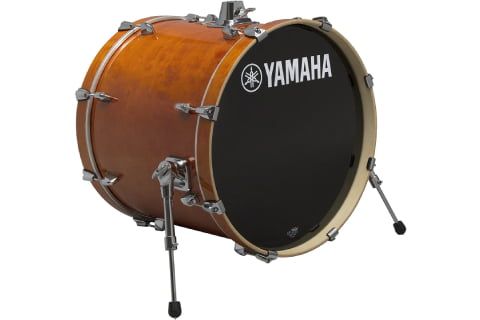
Also known as the kick drum, the bass drum is the largest type of drum within a drum set. It’s played with a bass drum pedal, which is operated with a foot.
The sound is produced when the pedal beater strikes the drumhead. The bass drum provides the punchy low-end tone of the drum set that drives the beat of a song. These drums are most commonly 20-24 inches in diameter but this can vary.
It serves an essential role in establishing the rhythm and feel of a song, providing the heartbeat and driving force behind the music.
Snare Drum
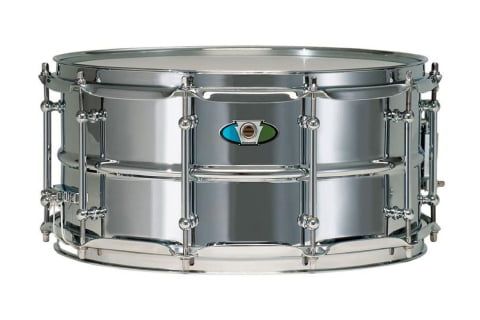
The snare drum is the iconic drum within modern music in the western world. It’s the most played drum within the drum set, and produces a distinctive high-end pop sound.
The snare drum features a selection of snare wires on the underside of the drum that resonates when the batter drum head is struck. This produces the iconic snappy sound that helps to drive the groove.
Snare drums are typically 13 or 14 inches in diameter, and they can also range vastly in depth, but are typically around 5.5 inches deep. While most drums are crafted from wood, snares are commonly made from metal such as steel, aluminium, bronze, copper, or brass.
The snare drum is an integral part of a drum set, providing rhythmic drive, accents, and dynamics to the music. Its distinctive sound can be heard in virtually all types of contemporary music.
Floor Tom
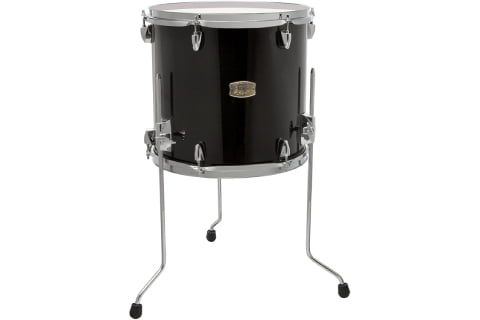
After the kick drum, the floor tom is the second-largest drum type found in a typical drum set. It produces a low-end boomy sound with a deep tone.
A floor tom is a drum that is an integral part of a standard drum set or drum kit. It is a large, deep-bodied drum that produces the lowest sounding tone of all the tom toms.
It’s commonly played within drum fills but it can also be used for funky grooves. Floor toms are typically 14 or 16 inches in diameter and they are positioned either on the floor using adjustable legs or attached to a stand with mounting brackets.
Rack Toms
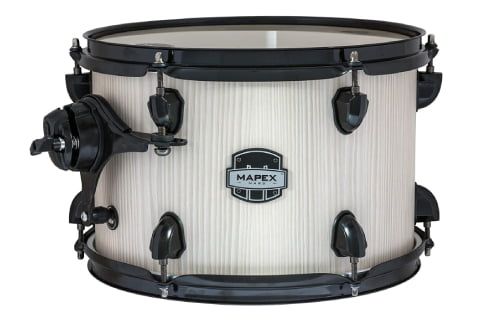
The last types of drums featured in a typical 5-piece drum set are the rack toms. The rack toms produce an open, resonant sound when struck with a defined pitch and tone.
The rack toms and floor tom are tuned to descend in pitch, helping to create a diverse range of sounds within drum fills and grooves.
Rack toms are most commonly 10 and 12 inches in diameter respectively in modern drum sets, but sizes can vary.
Types of Drums From Around the World
There are lots of different kinds of drums that pre-date the modern drum set. These types of percussion instruments have traditionally found their place within respective world music cultures, but they are also now used within popular western music. These types of drums are almost exclusively played with hands as opposed to drum sticks!
Bongos
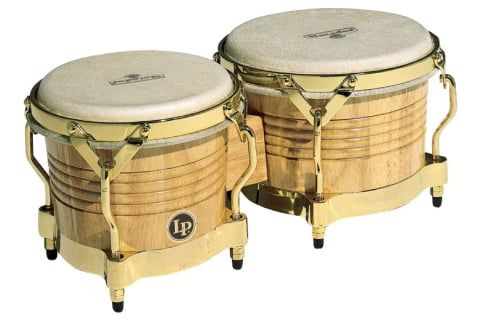
The bongos are an Afro-Cuban percussion instrument that consists of two individual drums that are known as the Macho and Hembra respectively.
They consist of two small drums, typically made from wood or fiberglass, which are joined together. The smaller drum is called the macho and the larger one is called the hembra. The drums traditionally feature raw animal hide drum skins.
Bongos are played by striking the drums with your hands and are played in between the legs of a drummer or mounted on a stand. They are versatile instruments that can be used in a variety of musical genres, including jazz, salsa, and pop music.
Djembes

A djembe drum is a large rope-tuned drum that originates from West Africa. The djembe alongside other African percussion instruments play a huge part in African culture, and they are played at events such as weddings and other celebrations.
The djembe is crafted from solid hardwood such as Mahogany and the drumhead is often rawhide animal skin. An interesting fact is that djembes are traditionally only played by men!
Cajons
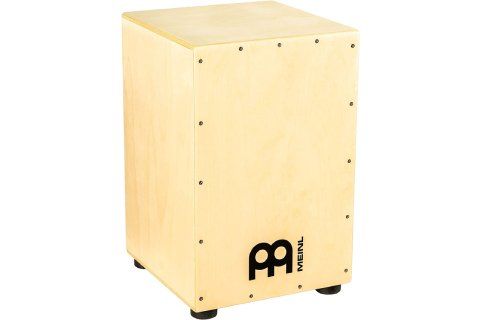
The cajon is a box-shaped percussion instrument that originates from Peru, and it’s now become one of the most popular drum types to be used for live acoustic performances.
The front face of the cajon is played with either hands, brushes, or drum sticks. Depending on where you strike the cajon it produces a wide range of sounds. The cajon is sat on whilst it’s played, which makes it amazingly portable and versatile as an instrument!
The cajon produces deep bass tones and crisp snare sounds, making it versatile for various genres like flamenco, Latin, and acoustic music.
Its compact size and portability make it an excellent choice for musicians who want to add rhythm to their performances without carrying around large drums.
Congas
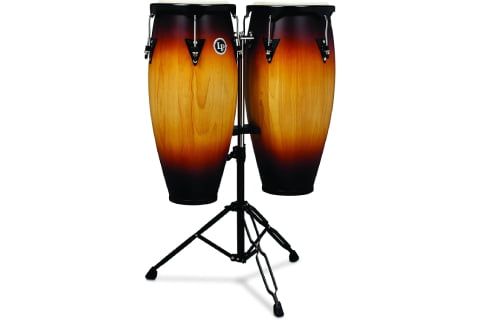
Conga drums are tall, large single-headed drums that look like barrels. They originate from Cuba and they were originally used in Afro-Cuban music and they are now very popular in Latin music amongst other genres.
Congas are one of the more popular drum types favored by percussionists for Latin American styles such as salsa and rumba. They feature a hardwood shell construction and need to be mounted on stands in order to be played.
With their unique sound and versatile playing techniques, congas add rhythmic flair to any musical ensemble. Exploring the world of congas will introduce you to a vibrant percussion instrument with rich cultural roots.
Tabla Drum
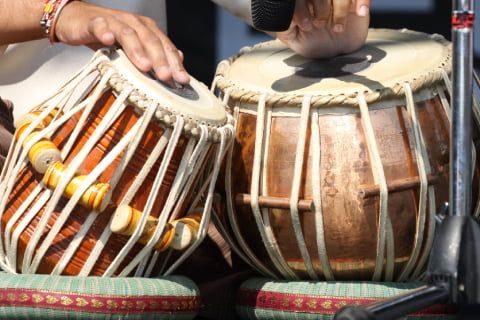
The tabla is the distinctive percussion instrument that originates from the Indian subcontinent. The tabla is fundamental to the Hindustani music of India, Pakistan, and Bangladesh.
It features two drums known as the Daya and Baya. The Daya is the higher-pitched of the two and is played to the right side, and it’s tuned to the tonic note of the raga (Indian scale). The Baya has a deeper sound and is made from copper, whilst the Daya is commonly made from wood.
The dayan is played with the fingers and produces higher pitched sounds, while the bayan is played with a wooden stick or palm and produces deeper tones.
Tablas are known for their versatility and rich tonal qualities, making them an essential instrument in Indian classical music. They are also used in various genres like folk, fusion, and world music.
Types of Drums Found in an Orchestra
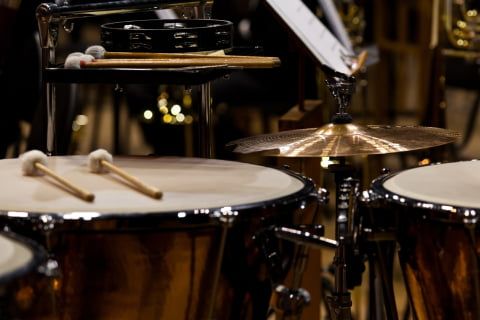
Orchestras utilize different types of drums within the percussion section to add rhythmic layers and intense dynamics within a composition.
There is an enormous range of auxiliary orchestral percussion including wood blocks, wind chimes, claves, guiros and more. Mallet percussion instruments such as the marimba and vibraphone are also prominent. But I will only be sharing the staple drums found within an orchestra.
Concert Bass Drum
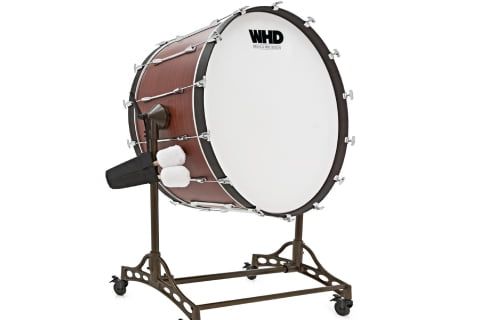
The concert bass drum in the orchestra is played standing up with a large mallet. It is much larger than a kick drum that is found in a drum set – up to 40 inches in diameter!
Concert bass drums are supported on a stand or sometimes suspended on a frame. They also have very little dampening which produces a very deep rumble with a long sustain.
Concert Snare Drum
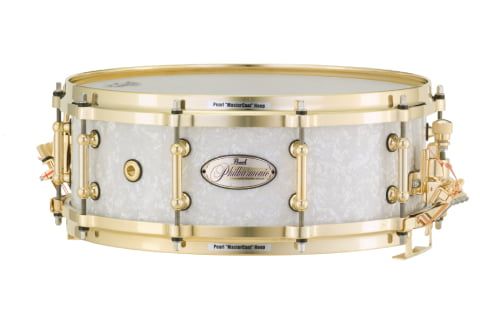
Concert snare drums reinforce rhythms within an orchestra with their easily recognizable short and snappy accents. Concert snares can be played with pianissimo dynamics all the way to loud whip-crack like punctuations.
The snare drum offers a military-type theme and sound that creates a consistent rhythmic feel with tight and precise sounds.
Timpani
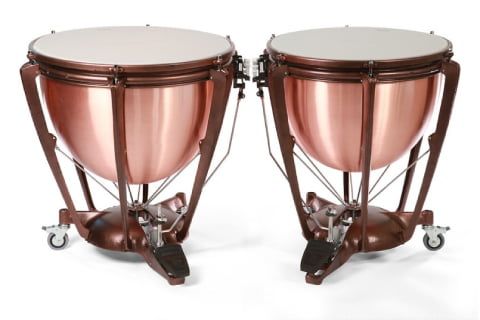
Arguably the most famous types of all the orchestral drum types – the timpani is a large copper drum that is tuned with a foot pedal to a desired pitch.
No orchestral percussion section is complete without a set of timpani! Orchestras most commonly feature four timpani. The timpani are struck with a mallet a few inches away from the edge, producing a round, resonant and full sound.
Timbales

Timbales are metal drums that originally come from Cuba. You’ll sometimes see drummers putting these in their drum kit setups, but they’re most often incorporated into percussion rigs.
They always come in pairs, with one timbale drum sounding higher-pitched than the other. The main sound they produce is a sharp attacking sound, and you can make that sound even more aggressive by playing rimshots.
Timbales don’t have any drumheads on the bottom side, which is the main reason for them having such short tones.
Types of Marching Band Drums
Marching bands utilize several types of drums, including the marching snare, multi-tenor drums, bass drum, and front ensemble.
Marching Snare Drum
A marching snare drum is an essential part of any marching band. These drums have a unique sound and play a crucial role in keeping the rhythm and energy of the performance alive.
Designed specifically for outdoor performances, marching snares feature shallow shells made of wood or metal, which produce loud and crisp sounds that can be heard over long distances.
With their distinctive sound and powerful projection, marching snare drums add excitement to parades, halftime shows, and other outdoor musical performances.
Multi-tenor
Multi-tenor drums are a type of marching band drum that consists of multiple small toms of different sizes mounted together. These drums usually come in sets of four, six, or eight and are played by a single drummer using mallets or sticks.
The multi-tenor drums produce different pitches depending on their size, allowing for melodic patterns and complex rhythms to be played. They add depth and color to the overall sound of a marching band and are often used to enhance musical arrangements during performances.
Multi-tenor drums require dexterity, coordination, and precision from the drummer to create rhythmic patterns that complement the rest of the ensemble.
Marching Bass Drum
The bass drum is a key component of marching band drums. It is the largest drum in the ensemble, and it produces a deep and powerful sound. This drum adds rhythm and impact to the music, serving as the heartbeat of the marching band.
It is played by striking it with a mallet or using a foot pedal to produce different tones and volumes. It creates a strong foundation for other instruments in the marching band, providing a solid beat that keeps everyone in sync.
Front Ensemble
The Front Ensemble is an important part of a marching band, adding depth and color to the group’s overall sound. It consists of various keyboard instruments like marimbas, vibraphones, xylophones, and synthesizers.
These instruments are played by skilled musicians who produce melodic lines and interesting textures that complement the rest of the band. The Front Ensemble enhances the musical experience for both performers and audiences alike with their unique sounds and energetic performances.
Types of Ethereal Drums
Handpans
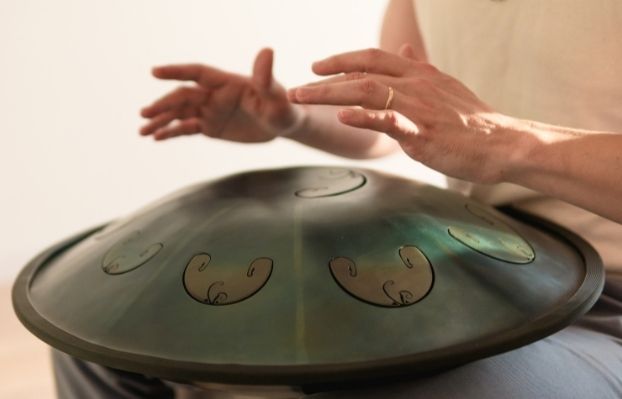
Handpans are large steel drums that players place on their laps to play. These fall under the category of pitched percussion, as they produce melodic notes. However, many people consider them as drums, as you play them by striking the surface with your hands.
Handpans produce ethereal sounds, and each handpan you see is designed to play a specific scale or mode. When players want to play different songs, they need to own several handpans to be able to match the key of various tunes.
Tongue Drums

Tongue drums are extremely similar to handpans, but they’re a lot more robust. They’re a bit smaller, and they’re also more affordable.
They have the same design in that you strike different areas on a tongue drum to play different notes, but the surfaces are harder to strike. So, most players use small mallets to play instead of using their hands.
With tongue drums being smaller than handpans, they’re also placed on your lap to play. However, you’ll often see players place them on the ground in front of them as well.
Taiko Drums

Taiko drums are traditional drums that are played in Japan. They come in all shapes and sizes, and there’s a whole cultural background to playing them.
When people learn to play taiko drums, they need to use very specific movements while playing. It’s very similar to various forms of martial arts, and taiko drums are often used during traditional ceremonies.
Players also need to wear traditional clothing while playing taiko drums for public performances.
Types of Electronic Drums
Electronic Drum Set
An electronic drum set is a modern and versatile alternative to traditional acoustic drum sets. It consists of electronic pads or triggers that produce sound via a drum module, replicating the sounds of various drums and cymbals.
Electronic drum kits consist of several drum pads, usually made of rubber or mesh, that are attached to a metal or plastic frame. These pads are designed to resemble the various drums and cymbals found in an acoustic drum set, including kick drums, snare drums, toms, hi-hats, and cymbals.
The sound module (or drum brain) is the central component of an electronic drum kit. It houses a wide range of pre-recorded drum sounds, samples, and electronic effects. Drummers can select different drum kits or customize their own sounds using the controls on the module. They also offer features like USB connectivity, MIDI compatibility, and built-in recording capabilities.
One of the main significant advantages of electronic drums is their ability to produce sound at lower volumes, making them ideal for practice sessions without disturbing others.
The quality of electronic drums has improved greatly in recent years, and they are very popular amongst beginners and professionals thanks to their versatility and low-volume.
Electronic Drum Pads
Electronic drum pads are compact and lightweight ‘all-inclusive’ versions of electronic drum kits. They feature several playable rubber pads and a drum brain in a single unit. The main surface is divided into various trigger zones that correspond to different drum sounds.
Electronic drum pads offer a wide range of built-in drum and percussion sounds. These can include different drum kits, cymbals, percussion instruments, and even non-drum sounds.
Connectivity options are another key aspect of electronic drum pads. They typically provide an extensive range of connectivity options, including MIDI, USB, and can accommodate for more external drum pads and drum triggers.
Electronic drum pads are ideal for live drummers as they can trigger samples and are easy to integrate within a conventional acoustic drum set, in order to form a hybrid drum set.
Types of Drums Summary
There we have it! These are the most common types of drums you will encounter in modern music.
There are of course, many more types of drums and percussion that exist in the world. But to detail them all in one guide would be almost impossible!
After all, drums are found within every culture on earth. But I hope this article has helped you to identify and understand the different drums you’re likely to encounter.

